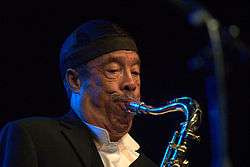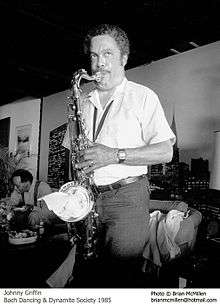Johnny Griffin
John Arnold Griffin III (April 24, 1928 – July 25, 2008) was an American jazz tenor saxophonist. Nicknamed "the Little Giant" for his short stature and forceful playing, Griffin's career began in the early 1940s and continued until the month of his death. At eighty, he felt no need to stop. He did not complain. He had a hard life, but often said, “as long as God has given me the gift to blow, I owe it to God to keep on blowing.” A pioneering figure in hard bop, Griffin recorded prolifically as a bandleader in addition to stints with pianist Thelonious Monk, drummer Art Blakey, in partnership with fellow tenor Eddie "Lockjaw" Davis and as a member of the Kenny Clarke/Francy Boland Big Band after he moved to Europe in the 1960s. In 1995, Griffin was awarded an Honorary Doctorate of Music from Berklee College of Music.[1]
Johnny Griffin | |
|---|---|
 Griffin performing in 2007 | |
| Background information | |
| Birth name | John Arnold Griffin III |
| Born | April 24, 1928 Chicago, Illinois, U.S |
| Died | July 25, 2008 (aged 80) |
| Genres | Jazz |
| Occupation(s) | Musician |
| Instruments | Tenor saxophone |
| Years active | 1940s–2008 |
| Labels | Blue Note, Riverside |
| Associated acts | Eddie "Lockjaw" Davis, Thelonious Monk, Kenny Clarke/Francy Boland Big Band |
Early life and career
Griffin studied music at DuSable High School in Chicago under Walter Dyett, starting out on clarinet before moving on to oboe and then alto sax. While still at high school at the age of 15, Griffin was playing with T-Bone Walker in a band led by Walker's brother.[2]
Alto saxophone was still his instrument of choice when he joined Lionel Hampton's big band three days after his high school graduation, but Hampton encouraged him to take up the tenor, playing alongside Arnett Cobb. He first appeared on a Los Angeles recording with Hampton's band in 1945 at the age of 17.
By mid-1947, Griffin and fellow Hampton band member Joe Morris had formed a sextet made up of local musicians, including George Freeman,[2] where he remained for the next two years. His playing can be heard on various early Rhythm and Blues recordings for Atlantic Records. By 1951 Griffin was playing baritone saxophone in an R&B septet led by former bandmate Arnett Cobb.[3]
After returning to Chicago from two years in the Army, Griffin began establishing a reputation as one of the premiere saxophonists in that city. Thelonious Monk enthusiastically encouraged Orrin Keepnews of Riverside Records to sign the young tenor, but before he could act Blue Note Records had signed Griffin.
He joined Art Blakey's Jazz Messengers in 1957, and his recordings from that time include a memorable album joining together the Messengers and Thelonious Monk. Griffin then succeeded John Coltrane as a member of Monk's Five Spot quartet; he can be heard on the albums Thelonious in Action and Misterioso.
Griffin's unique style, based on an astounding technique, included a vast canon of bebop language. He was known to quote generously from classical, opera and other musical forms. A prodigious player, he was often subjected to and victorious at "cutting sessions" (a musical battle between two musicians) involving a legion of tenor players, both in his hometown Chicago with the likes of Hank Mobley and Gene Ammons, and on the road. Diminutive, he was distinctive as a fashionable dresser, a good businessman, and a well-liked bandleader to other musicians.
Recording career

Griffin was leader on his first Blue Note album Introducing Johnny Griffin in 1956. Also featuring Wynton Kelly on piano, Curly Russell on bass and Max Roach on drums, the recording brought Griffin critical acclaim.
The album A Blowin' Session (1957) featured John Coltrane and Hank Mobley. He played with Art Blakey's Jazz Messengers for a few months in 1957, and in the Thelonious Monk Sextet and Quartet (1958). During this period, he recorded a set with Clark Terry on Serenade to a Bus Seat featuring the rhythm trio of Wynton Kelly, Paul Chambers, and Philly Joe Jones.
Move to Europe
Griffin moved to France in 1963 and to the Netherlands in 1978. His relocation was the result of several factors, including income tax problems, a failing marriage and feeling "embittered by the critical acceptance of free jazz" in the United States, as journalist Ben Ratliff would write.[4] Apart from appearing regularly under his own name at jazz clubs such as London's Ronnie Scott's, Griffin became the "first choice" sax player for visiting US musicians touring the continent during the 1960s and '70s. He briefly rejoined Monk's groups (an Octet and Nonet) in 1967.
Griffin and Davis met up again in 1970 and recorded Tough Tenors Again 'n' Again, and again with the Dizzy Gillespie Big 7 at the Montreux Jazz Festival. In 1965 he recorded albums with Wes Montgomery. From 1967 to 1969, he was part of the Kenny Clarke/Francy Boland Big Band and in the late '70s recorded with Peter Herbolzheimer and His Big Band, which also included, among others, Nat Adderley, Derek Watkins, Art Farmer, Slide Hampton, Jiggs Whigham, Herb Geller, Wilton Gaynair, Stan Getz, Gerry Mulligan, Rita Reys, Jean "Toots" Thielemans, Niels-Henning Ørsted Pedersen, Grady Tate, and Quincy Jones as arranger. He also recorded with the Nat Adderley Quintet in 1978, having previously recorded with Adderley in 1958.
On July 25, 2008, Johnny Griffin died of a heart attack at the age of 80 in Mauprévoir, near Availles-Limouzine, France,[5] His last concert was in Hyères, France on July 21, 2008.
Discography
As leader
- 1956: Johnny Griffin (Argo, 1958)
- 1956: Introducing Johnny Griffin (Blue Note)
- 1957: A Blowing Session (Blue Note)
- 1957: The Congregation (Blue Note)
- 1958: Johnny Griffin Sextet (Riverside)
- 1958: Way Out! (Riverside)
- 1959: The Little Giant (Riverside)
- 1960: The Big Soul-Band (Riverside)
- 1960: Battle Stations (Prestige)
- 1960: Johnny Griffin's Studio Jazz Party (Riverside)
- 1960: Tough Tenors (Jazzland)
- 1960: Griff & Lock (Jazzland)
- 1961: The First Set (Prestige)
- 1961: The Tenor Scene (Prestige)
- 1961: The Late Show (Prestige)
- 1961: The Midnight Show (Prestige)
- 1961: Lookin' at Monk! (Prestige)
- 1961: Change of Pace (Riverside)
- 1961: Blues Up & Down (Jazzland)
- 1961: White Gardenia (Riverside)
- 1961: The Kerry Dancers (Riverside)
- 1962: Tough Tenor Favorites (Jazzland)
- 1962: Grab This! (Riverside)
- 1963: Soul Groove (Atlantic) with Matthew Gee
- 1963: Do Nothing 'til You Hear from Me (Riverside)
- 1964: Night Lady (Philips)
- 1967: The Man I Love (Polydor)
- 1967: You Leave Me Breathless (Black Lion)
- 1967: A Night in Tunisia (Trio)
- 1967: Body and Soul (Moon)
- 1968: Jazz Undulation (Joker)
- 1968: Lady Heavy Bottom's Waltz (Vogue)
- 1970: Tough Tenors Again 'n' Again (MPS)
- 1973: Blues for Harvey (SteepleChase)
- 1974: Johnny Griffin Live at Music Inn (Horo)
- 1975: All the Things You Are (Timeless)
- 1976: Johnny Griffin Live in Tokyo (Philips)
- 1976: The Little Giant Revisited (Philips)
- 1978: Sincerely Ours (Four Leaf Clover) with Rolf Ericson
- 1978: Return of the Griffin (Galaxy)
- 1978: Bush Dance (Galaxy)
- 1978: Birds and Ballads (Galaxy)
- 1979: NYC Underground (Galaxy)
- 1979: To the Ladies (Galaxy)
- 1980: Live / Autumn Leaves (Verve)
- 1981: Meeting (Jeton)
- 1983: Call It Whachawana (Galaxy)
- 1984: Tenors Back Again! (Storyville)
- 1985: Three Generations of Tenor Saxophone
- 1986: Have You Met Barcelona
- 1988: Take My Hand (Who's Who in Jazz)
- 1990: The Cat (Antilles)
- 1992: Dance of Passion (Antilles)
- 1994: Chicago-New york-Paris
- 1995: Chicago, New York, Paris (Verve/Polygram)
- 1999: In and Out (Dreyfus)
- 2000: Johnny Griffin and Steve Grossman Quintet
- 2000: Johnny Griffin and Horace Parlan: Close Your Eyes (Minor Music)
- 2002: Johnny Griffin and the Great Danes
As sideman
With Ahmed Abdul-Malik
- Jazz Sahara (Riverside, 1958)
- East Meets West (RCA Victor, 1960)
With Nat Adderley
- Branching Out (Riverside, 1958)
- A Little New York Midtown Music (Galaxy, 1978)
With Chet Baker
- Chet Baker in New York (Riverside, 1958)
With Count Basie
With Art Blakey
- Selections from Lerner and Loewe's... (Vik, 1957)
- A Night in Tunisia (Vik, 1957)
- Cu-Bop (Jubilee, 1957)
- Art Blakey's Jazz Messengers with Thelonious Monk (Atlantic, 1957)
- Hard Drive (Bethlehem, 1957)
With James Carter
- Live at Baker's Keyboard Lounge (Warner Bros., 2001 [2004])
With the Kenny Clarke/Francy Boland Big Band
- Sax No End (SABA, 1967)
- Out of the Folk Bag (Columbia, 1967)
- 17 Men and Their Music (Campi, 1967)
- All Smiles (MPS, 1968)
- Faces (MPS, 1969)
- Latin Kaleidoscope (MPS, 1968)
- Fellini 712 (MPS, 1969)
- All Blues (MPS, 1969)
- More Smiles (MPS, 1969)
- Volcano (Polydor 1969)
- Clarke Boland Big Band en Concert avec Europe 1 (Tréma, 1969 [1992])
With Tadd Dameron
- The Magic Touch (Riverside 1962)
With Dizzy Gillespie
- The Giant (America, 1973)
- The Source (America, 1973)
- The Dizzy Gillespie Big 7 (Pablo, 1975)
With Bennie Green
- Glidin' Along (Jazzland 1961)
With Philly Joe Jones
- Blues for Dracula (Riverside, 1958)
- Look Stop Listen (Uptown, 1983) with Dameronia
With Johnny Lytle
- Nice and Easy (Jazzland, 1962)
With Blue Mitchell
- Big 6 (Riverside 1958)
With Thelonious Monk
- Thelonious in Action (Riverside 1958)
- Misterioso (Riverside 1958)
With Bud Powell
- Bud in Paris (1975, Xanadu) (recorded live 1960)
- Earl Bud Powell, Vol. 8: Holidays in Edenville, 64 (Mythic Sound, 1964)
With A. K. Salim
- Stable Mates (Savoy, 1957)
- Pretty for the People (Savoy, 1957)
With Ira Sullivan
- Blue Stroll (Delmark, 1961)
With Clark Terry
- Serenade to a Bus Seat (Riverside, 1957)
With Wilbur Ware
- The Chicago Sound (Riverside, 1957)
With Randy Weston
- Little Niles (United Artists, 1958)
With Wes Montgomery
- Full House (Riverside, 1962)
References
- Zwerin, Mike (August 9, 1995). "Berklee, the Brand Name of Music Schools". Nytimes.com.
- "In Conversation with Johnny Griffin" Archived March 18, 2010, at the Wayback Machine by Ted Panken at Jazz.com Archived October 21, 2015, at the Wayback Machine
- Johnny Griffin catalog jazzdisco.org. Retrieved July 8, 2013.
- Ratliff, Ben (2008). "Johnny Griffin, 80, Jazz Saxophonist, dies." The New York Times, July 26, 2008; accessed 12 September 2016
- (in French) "Le saxophoniste américain Johnny Griffin est mort" Le Nouvel Observateur. Retrieved October 19, 2013.
Bibliography
- Mike Hennessey The Little Giant: The Story of Johnny Griffin. London: Northway Publications, 2008. ISBN 978-0-9550908-5-1